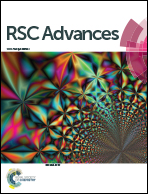Remarkable enhancement of the catalytic performance of molybdenum sulfide catalysts via an in situ decomposition method for higher alcohol synthesis from syngas†
Abstract
Nickel-containing and nickel-free molybdenum sulfide catalysts were prepared by an in situ thermal decomposition method. Their catalytic performance was investigated for higher alcohol synthesis from syngas. It is surprising that the Ni-promoted and the nickel-free catalysts prepared by in situ decomposition showed significantly higher activity featuring space-time-yield (STY, mg g−1 h−1) values of 520 and 510 respectively, while the ex situ method resulted in K–Ni–MoS2-E and K–MoS2-E catalysts with low activities featuring STY values of 370 and 170 mg g−1 h−1, respectively. The remarkable difference in catalytic activities was due to the fact that the in situ decomposition method can result in disordered MoS2 domains and exposure to more coordinated unsaturated sites by the formation of smaller particles. In addition, the excellent catalytic performance was also associated with the combined impact of the in situ preparation method and Ni promotion.


 Please wait while we load your content...
Please wait while we load your content...